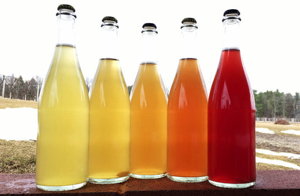You might think that all bubbles are created equal, but that couldn’t be farther from the truth. There are actually six different ways of producing sparkling wines that result in wines with different characters, textures, flavors and price ranges. However, have you ever thought about how sparkling wine first came to be?
You might be surprised to know that Champagne was not the world’s first sparkling wine. In fact, Champagne’s “Traditional Method” of making sparkling wine came along 200 years after sparkling wine was first developed. The very first manner of producing sparkling wine is called the “Ancestral Method” and the first recorded reference to it was in 1531 in Languedoc in southern France.
This ancient method of making sparkling wine is now experiencing a big resurgence in popularity, and these wines are definitely worth seeking out, so let’s delve a little deeper and learn more about wines made using the Ancestral Method.
Names on the label:
- Pét-nat (Pétillant Naturel)
- Col Fondo
- Methode Ancestral
- Bottle Fermented
How its made:
- Not only is this the oldest way of making sparkling wine, it is also the simplest method – so simple, in fact, that it probably first happened by accident!
- A still wine is bottled before alcoholic fermentation is completed, leaving some residual sugar and yeast left in the wine.
- The fermentation continues in the bottle, with the yeast converting the remaining sugar into alcohol and releasing carbon dioxide (CO2) as a by-product of fermentation. The CO2 bubbles are absorbed into the wine, creating a sparkling wine.
- Some Pét-nats are left unfined and unfiltered, meaning they can have a hazy or cloudy appearance due to yeast cells left in the wine.
- These wines are often closed with a crown cap (beer-bottle cap) rather than a cork, reflecting the informal style of these wines.
What it tastes like:
- The fun thing about Pét-nats is they can be made from any grape variety and are produced all over the world. The small producers who are making these wines today love to experiment with unusual, little known varietals. Because of this, there is no typical flavor profile for Pét-nats, but its a great way to explore grapes you have never heard of before!
- Pét-nats displays calmer foam, typically with larger bubbles on the palate. The lower pressure of pét-nats allows for a more generous aroma upon opening the bottle.
- A pét-nat’s bubbles often become softer and smaller as it ages so are meant to be drunk young and not cellared for a long period of time.
- Those that are hazy and unfiltered can have a creamier texture, as well as biscuity, bready flavors imparted by the yeast cells remaining in the wine.
- Most pét-nats tend to be fairly low in alcohol—often under 13% ABV— and so they’re usually refreshing and easy drinking.
Where to find them
- Pét-nats tend to cost in the range of $18-$35.
- They can be difficult to find in supermarkets and big chain wine stores. You will have better luck finding them in Natural Wine shops and boutique wine shops.
- Many small, local wineries are now producing Pét-nats because they are easy and cost-effective to produce, so take a look at the wineries in your home state as they may be producing some excellent Pét-nats. In fact, the best one I’ve ever had was made in my home state of New Jersey with chenin blanc grapes. This is also a great way to support a local business!





